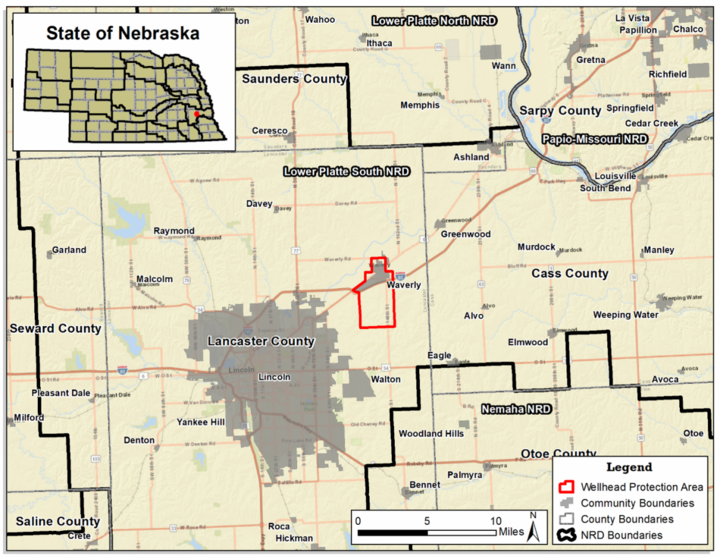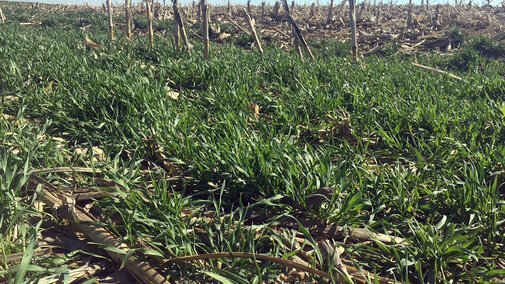Nitrate Challenges
Several communities in Nebraska are facing growing concerns of increasing groundwater nitrate concentration in their municipal wells. As nitrate concentrations in the groundwater continue to increase, these communities, including Waverly (Figure 1), are facing expensive water treatment options to continue providing safe drinking water to the communities. While low nitrate concentrations in groundwater can occur naturally, the major source of groundwater nitrate in agriculturally dominated areas is nitrogen fertilizer when applied in excess amounts. The implementation of best nutrient management practices is one way to optimize nitrogen inputs, improve nitrogen use efficiency, reduce nitrate leaching to groundwater and assure a safe drinking water supply (See Agronomic Management for Reduced Nitrate Leaching).
Growing cover crops during the winter fallow period is one of the best management practices for reducing nitrate leaching and improving soil resilience. Cover crops established in the fall after the harvest of main crops can retain nitrogen in the upper layers of the soil profile, decrease nitrate leaching into the groundwater and recycle nutrients back to the soil once they are terminated. The cover crops also act as a sink for atmospheric carbon dioxide and add organic matter to the soil, which tends to reduce soil erosion and increase soil water holding capacity, thereby decreasing the potential for nitrate leaching. In addition, cover crops can suppress weeds and potentially limit the use of herbicides.

Impact
Planting cover crops during the winter fellow period has potential for on-farm and off-site benefits. The preliminary data presented here demonstrates the ability of cover crops to recapture nitrogen as it moves through the soil profile during the fallow winter period, thus reducing the negative environmental impacts of excess nitrogen fertilizer use on drinking water quality in the municipal wells.
Preliminary Cover Crop Study
In partnership with the City of Waverly, Lower Platte South NRD (LPSNRD), and Nebraska Department of Environment and Energy (NDEE), we conducted a preliminary study at the wellhead protection area in Waverly, Nebraska. In this study, we measured the effect of rye cover crops on reducing nitrate leaching to groundwater. Cereal rye cover crops were drilled following the corn harvest of 2020 at two seeding rates of 50 lbs/acre and 75 lbs/acre in replicated plots. Check plots without cover crops were included for comparison purposes. Before cover crop termination, soil samples at four soil sampling depths (0-12, 12-24, 24-36, 36-48 inches) were collected to evaluate soil nitrate depletion with cover crop during the fallow winter period. Rye biomass samples were also collected before terminating the rye cover crop in April 2021.
Results

Cover crops decreased soil nitrate concentration at all four soil depths (Figure 2). When averaged across soil depths, cover crop treatments decreased soil NO3- to 1.8 lb-N/ac at the 50 lb/ac rye seeding rate and 4.18 lb-N/ac at the 75 lb/ac seeding rate. In comparison, soil NO3- was 20 lb-N/ac in plots without cover crops (Figure 2). The decrease in NO3- in shallow and deeper soil indicates that cover crops can deplete soil NO3- nitrogen during the spring period when the available soil nitrate is susceptible to nitrate leaching, especially in cases of early thaw or wet spring.
Though we did not see significant differences of NO3- depletion in soil between two cover crop seeding rates, a high seeding rate of 75 lbs/acre produced higher crop biomass and took up three times more N (71 lbs N/acre) compared to low cover crop seeding rate of 50 lbs/acre (24 lbs N/acre) (Table 1). The nitrogen in the cover crop biomass is generally released after cover crop termination and becomes available for the main crop during the growing season. The nitrogen released from the cover crop is dependent on several factors related to residue quality, environmental and management variables (see more in this cover crop nitrogen release article).
Overall, the preliminary results indicate that growing a cereal rye cover crop during the fallow winter period can not only lower the potential for nitrate leaching but may also reduce the amount of N needed in season resulting in nitrogen fertilizer cost savings. As expected, the cover crop did not affect soil organic matter in this study, as organic matter changes due to cover crop are generally not seen in a single growing season of the cover crop. A long-term study can help to answer questions on cover crop effect on soil properties.
| Cereal Rye Seeding Rate | Cover crop biomass (lb/acre) | N in biomass (lbs N/acre) | C:N ratio of biomass |
|---|---|---|---|
| 50 lbs N/acre | 1065 | 24 | 19 |
| 75 lbs N/acre | 2215 | 71 | 14 |
Summary
The data in this preliminary study has shown that during the winter fallow period, the cereal rye cover crop can accumulate a significant amount of N into its biomass, lower soil NO3-, and reduce the potential for nitrate leaching. Though we did not find differences in soil organic matter due to cover crops in one growing season, we plan to continue this study to answer several questions related to soil conservation and soil health, nutrient uptake and release, nitrogen availability for the crops and nitrate leaching. We appreciate the partnership with the City of Waverly, Lower Platte South NRD (LPSNRD), and the Nebraska Department of Environment and Energy (NDEE) for the continued support.

